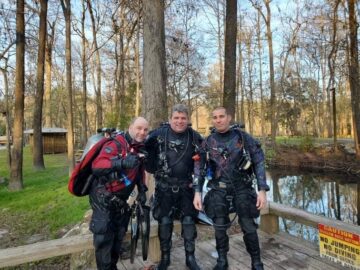NAUI Cave Guide
The NAUI Cave Guide Program was designed to train knowledgeable Instructors, Divemasters, and Assistant Instructors who are certified NAUI Cave 2 Divers to act as part of a support team for Cave/Cavern diving, training activities and guiding Cave/Cavern dives in the physical overhead environment to the level to which the Cave guide is certified.
The NAUI Cave Guide Course allows for certified Cave Guides to become eligible for Professional Liability Insurance without having to become Instructors, so you can enjoy your time in the Caves and Cenotes more, doing the dives you love the most.

Upon successful completion of the NAUI Cave Guide Course, graduates are considered competent to plan and execute guided dives in portions of a cavern or cave in which they have completed at least 25 previous dives and are qualified to provide assistance to teams of Cave/Cavern divers, assist during training or post certification diving activities, and guide Cave/Cavern dives provided diving conditions and methods approximate those in which the Cave Guide was trained.
These duties may possibly include shuttling of equipment, removal and replacement of staged decompression gases and equipment, rigging and setting up of decompression stations and gases, monitoring divers during ascent and staged decompression stops, and assisting with emergency evacuation. An active-status NAUI Cave Guide is qualified to assist an active-status NAUI Technical Instructor in Cave/Cavern diving instruction.
PREREQUISITES
- Age. Minimum is 18 years by the water phase of the course.
- Certification/Experience/Knowledge.
o Active-status NAUI Assistant Instructor, Divemaster, Instructor
o NAUI Cave Level II Diver or equivalent
o Proof of at least 100 logged cave dives and 80 hours of overhead time after NAUI Cave II or equivalent.
The minimum number of dives is four.
- ◊ one cavern guide dive.
- ◊ three cave guide dives.
- – At least two dives must require complex navigation
- – At least one dive must require stage bottle useLIMITATIONS.– The Cave Guide Must be equally qualified or higher than individuals being guided – There must be a continuous guideline to open water when in a cavern or cave.
– 140 cubic ft. for overhead dives.
Equipment. For purposes of safety, uniformity of instruction, and functionality, instructor and students are required to utilize at a minimum, the NTEC gear configuration required for a cave diver. The following equipment is required in addition to that required by NAUI Cave Diver Level I:
Jump/gap reels or spools as required.
Slate and writing implement
Bottom-gas stage cylinder properly rigged and labeled. Decompression cylinder properly rigged and labeled.
REQUIREMENTS – ACADEMIC (Remediation of specific subject knowledge as needed.)
Coverage is to include: The NAUI guiding policies, the guiding process, types of guided dives, accident analysis, diving limitations including the rule of thirds with multiple dissimilar cylinder sizes, restrictions on dive time management within the no-decompression limits for overhead diving, NTEC as it relates to divers being guided, factors associated with task loading, stress, perceptual narrowing, and panic for guided divers, guideline recognition factors for guided dives, team communication procedures, problem solving and emergency planning for guided dives, limitations for cave navigation with multiple guidelines, single file passage.
REQUIREMENTS – SKILLS
Students are to analyze their own breathing gas mixture (if breathing EANx) and plan and safely execute each dive.
Dive planning shall include limits for: team gas consumption following the rule of thirds and for decompression stops if required, oxygen toxicity exposures and time limitations, inert gas absorption based on depth and time, and required decompression if necessary, penetration distance within diver limits, diver comfort.
Safety drills are to be performed at the beginning of every dive to include: equipment check, dive plan and limitation review, bubble check, and gas sharing.
During land drills each student must:
Demonstrate team placement procedures.
Demonstrate team process for lost diver and lost line procedures.
Demonstrate team conduct for zero visibility/touch contact communications while following a line. Demonstrate the use of general navigational markings.
Demonstrate jump/gap reel or spool deployment with navigational aids.
In open water each student must:
Demonstrate appropriate guideline following, with touch contact communications while sharing gas and simulating zero visibility.
Demonstrate proper horizontal buoyancy control and trim while hovering without propulsion. Demonstrate the ability to propel backward for 3m (10 ft.).
Demonstrate the ability to turn 360 degrees in a stationary horizontal position.
Demonstrate a simulated primary regulator failure, isolation, shutdown, and switchover procedure within 15 seconds.
Demonstrate a rescue of a diver simulating oxygen toxicity symptoms.
In the cavern each student must:
Demonstrate guideline deployment and removal techniques including team position responsibilities and roles.
Demonstrate a simulated primary light failure, deployment of a backup light, and exit within the dive team protocol (while maintaining proper buoyancy and trim).
Demonstrate the proper team procedure of a lost teammate drill.
Demonstrate the proper team procedure for a lost line drill.
In the cave each student must:
Demonstrate the ability to install a jump/gap reel or spool with the proper navigational indicators.
In a simulated zero visibility situation, with a simulated out-of- gas teammate, maintain touch contact communications for 30m (100 ft.) while maintaining proper buoyancy and trim.
Cost $600
Take NAUI Cave & Technical Diver Training with Dan’s Dive Shop. Mexico, Dominican, Florida and more.
